Bowel cancer rates are soaring in the under-50s – is this the reason why?
It’s not talked about as much as protein, but Brits are eating fibre at dangerously low levels, which is leading to increases in bowel cancer. From good gut health to mental wellbeing, Hannah Twiggs speaks to a nutritionist about how to get the exact right amount in our diet the easy way


Ask someone about protein and they’ll evangelise about chicken breasts, spirulina and the dubious virtues of whey powder. Ask about fibre and you’ll likely get a blank stare or – if you’re lucky – a muttered reference to Bran Flakes. It turns out the most essential nutrient for long-term health is also the least talked about.
NHS guidance advises that adults should consume at least 30g of the nutrient every day, but data released by the Government’s Office for Health Improvement and Disparities (OHID) has shown a staggering 96 per cent of adults are now not meeting this requirement.
Vital for digestion and a healthy gut, these findings also come at a time when rates of bowel cancer are rising, especially among people in their twenties, thirties and forties. As rates soar among the under-50s, research now suggests that more than a quarter (28 per cent) of all bowel cancer cases in the UK could be caused by eating too little fibre
So, why does fibre get so little love? Jo Travers, expert nutritionist and dietitian for Discover Great Veg, has a theory. “Fibre has historically been associated with keeping people ‘regular’, which is not exactly exciting!” Essentially, fibre has an image problem. While protein gets gym bros and wellness influencers, fibre is stuck with prunes and allusions to bowel movements.
It’s time to change that. Because fibre isn’t just about digestive and gut health; it supports mental wellbeing, heart health, metabolism and even disease prevention. And it’s hidden in some of the best foods going – think kale, cavolo nero (a type of kale), pulses, nuts and berries. The good news? Getting more of it is easy. The bad news? We need to care enough to do it.
The fibre deficit: why are we so bad at eating it?
Part of the problem is convenience culture. “There has been a huge decline in fibre intakes with refined carbohydrates making up the bulk of people’s carbohydrate intake,” says Travers. “The wholegrain versions of these seem a bit boring or not as tasty.” White bread, white rice, white pasta – easy, fluffy and designed to disappear quickly. Compare that to their wholegrain equivalents, which require chewing and you start to see why we’re all struggling.
There’s also the ultra-processed food factor. “One of the things you rarely find in some ultra-processed foods is fibre,” Travers explains. “Because so much of the Western diet is made up of ultra-processed foods, it means that the gut microbiome can sometimes miss out on a source of food, and this can lead to a less diverse microbiome, less able to produce all of the beneficial compounds that keep us healthy.”
That’s the kicker: we’re not just missing out on roughage; we’re depriving our gut bacteria of the fuel they need to keep us functioning properly. And when our gut microbiome suffers, so does everything else.
The science of fibre: your body’s unsung hero
Fibre isn’t just a single nutrient – it’s an umbrella term for various plant-based compounds that our bodies can’t digest but that our gut bacteria can. There are different types, each playing an essential role. Soluble fibre dissolves in water, forming a gel that slows digestion, keeps us fuller for longer and lowers blood sugar and cholesterol.
Oats, beans and fruit are rich sources of soluble fibre. Insoluble fibre doesn’t dissolve but instead bulks out our stools and keeps food moving through our digestive system. Wholegrains, leafy greens and nuts fit the bill. Prebiotic fibre feeds the good bacteria in our gut, which in turn produce vitamins and chemical messengers that interact with the immune system and even communicate with the brain.
Travers explains: “It used to be thought that fibre just travels straight through us, not really doing much except helping food move through the gut. We now know, however, that it is essential for keeping the gut microbiome healthy.”
The gut, it turns out, isn’t just a digestion centre; it’s an information hub. When gut bacteria digest fibre, they produce short-chain fatty acids that influence everything from immune function to mental health. “Bacteria in the gut eat the fibre from our diet and in turn produce chemical messengers such as serotonin, that communicate with the brain along the gut-brain axis,” says Travers. “Studies have found that increasing the fibre in your diet can reduce depression and anxiety.”
There is also emerging research looking at fibre’s role in cognitive health. Early studies suggest that eating more fibre could increase the volume of grey matter in the brain, potentially slowing the progression of diseases like Alzheimer’s. While the science is still developing, it adds to the growing list of reasons to prioritise fibre.
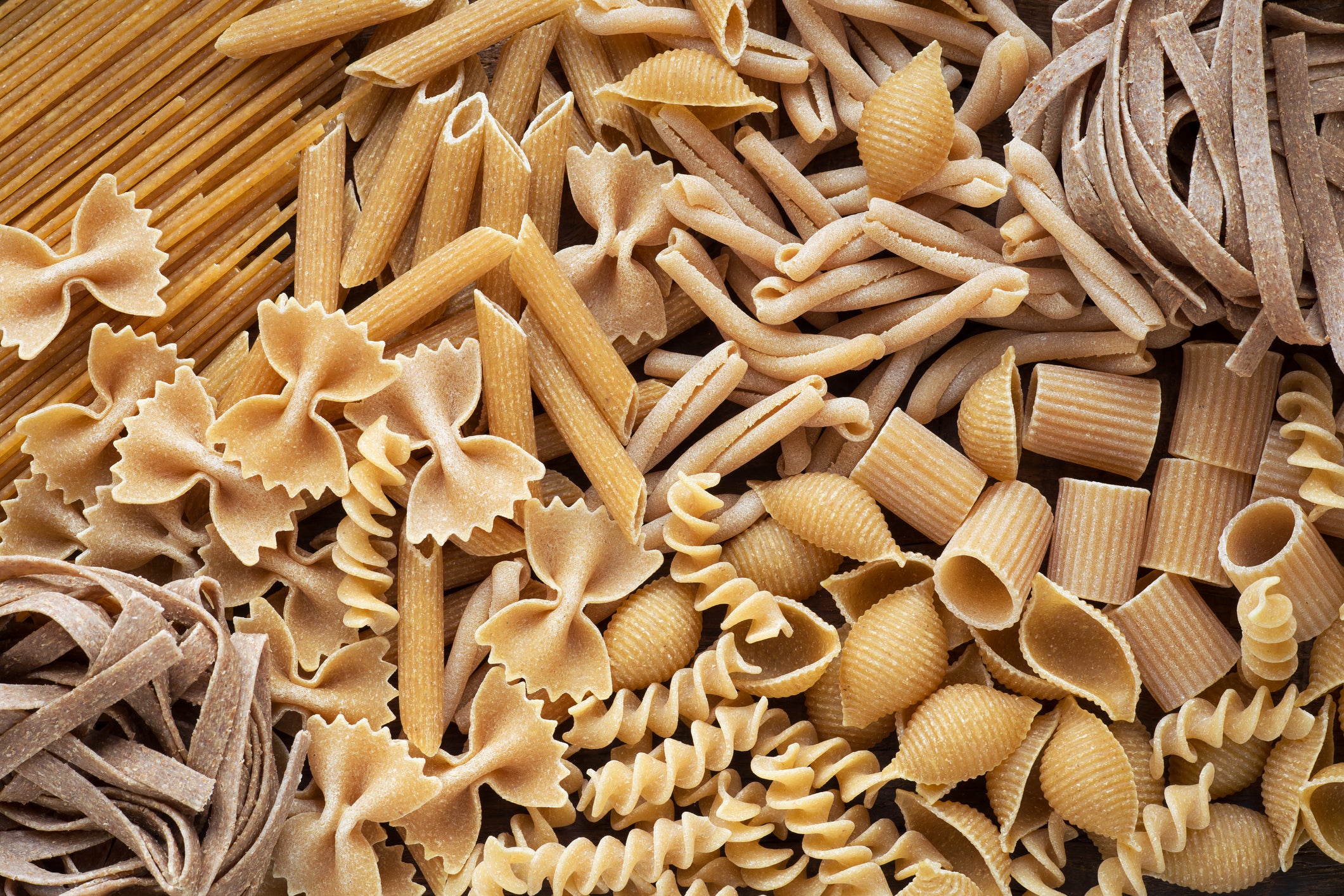
Fibre is sexy (no, really)
Fibre’s greatest tragedy is that it’s been branded as dull when, in reality, it’s in some of the most flavour-packed, satisfying foods available. The idea that fibre means cardboard-like breakfast cereals and bland grains is outdated. Kale, cavolo nero, walnuts, raspberries, chickpeas – these are all fibre powerhouses.
“It’s easy to make fibre-rich foods taste great,” says Travers. “Even if you aren’t a fan of vegetables by themselves, adding a dash of olive oil, garlic, herbs or spices can transform them into something much more interesting. And adding a couple of handfuls of leafy greens to a curry or a pasta sauce not only makes it more nutritious but also improves the flavour too.”
Surprisingly, dark chocolate, avocados and nuts are also excellent sources of fibre, proving that eating well doesn’t have to mean giving up indulgence.
How to eat more fibre without overhauling your life
The good news is that increasing fibre intake doesn’t require a radical diet change. In fact, “there are three really easy ways to increase fibre without changing much at all,” says Travers. Doubling the portion size of vegetables at meals is an easy place to start. Instead of having just a handful of greens, aim for two.
Swapping white carbohydrates for wholegrain versions, such as brown rice, granary bread or lentil pasta, is another simple shift with big benefits.
Top 10 benefits of fibre
1. Supports gut health
2. Can help improve mood
3. Helps maintain a healthy weight
4. Can improve metabolic health
5. Lowers risk of cardiovascular disease
6. Lowers risk of diabetes
7. Lowers risk of bowel cancer
8. Supports brain health
9. Supports energy levels
10. Can help prevent constipation
Adding extra fibre to meals doesn’t need to be complicated – just throw a handful of fresh or frozen vegetables, beans or lentils into whatever you’re cooking. Tinned lentils can be stirred into pasta sauces and spinach can be added to a chicken curry without changing the dish’s overall flavour.
For those who experience bloating when increasing their fibre intake, Travers advises drinking more water and adding fibre gradually. “Fibre either dissolves or absorbs water in the gut, so if you increase fibre, increase your fluid intake a bit too. If you still feel you have some bloating, then you may need to add the fibre a bit more gradually.”
Fibre deserves a rebrand
The message is simple: eat more fibre and your body will thank you. From gut health to mood, heart health to longevity, fibre is the one nutrient that does it all. And, as Travers points out, “Even if you don’t quite make the 30g straight away, any increase is positive!”
So consider this your challenge: tomorrow, try hitting 30g of fibre. Your gut, your brain and your tastebuds will thank you.
The fibre-rich recipes to prove the point
Still think fibre means bland? These five dishes will change your mind. The ginger-harissa-roasted vegetable pilaf is smoky, spiced and packed with 24g of fibre per portion. The winter kale salad is a vibrant mix of kale, quinoa and walnuts, delivering an impressive 21g of fibre.
The tofu, spinach and bean soup is hearty, warming and offers 19g of fibre in a single serving. For something rich and comforting, the creamy potato and kale curry is proof that comfort food can be gut-friendly, with 18g of fibre.
And for those who love pasta, the kale and walnut pasta primavera combines wholewheat pasta with greens and nuts, delivering 13g of fibre per portion.
Ginger-harissa-roasted vegetable pilaf
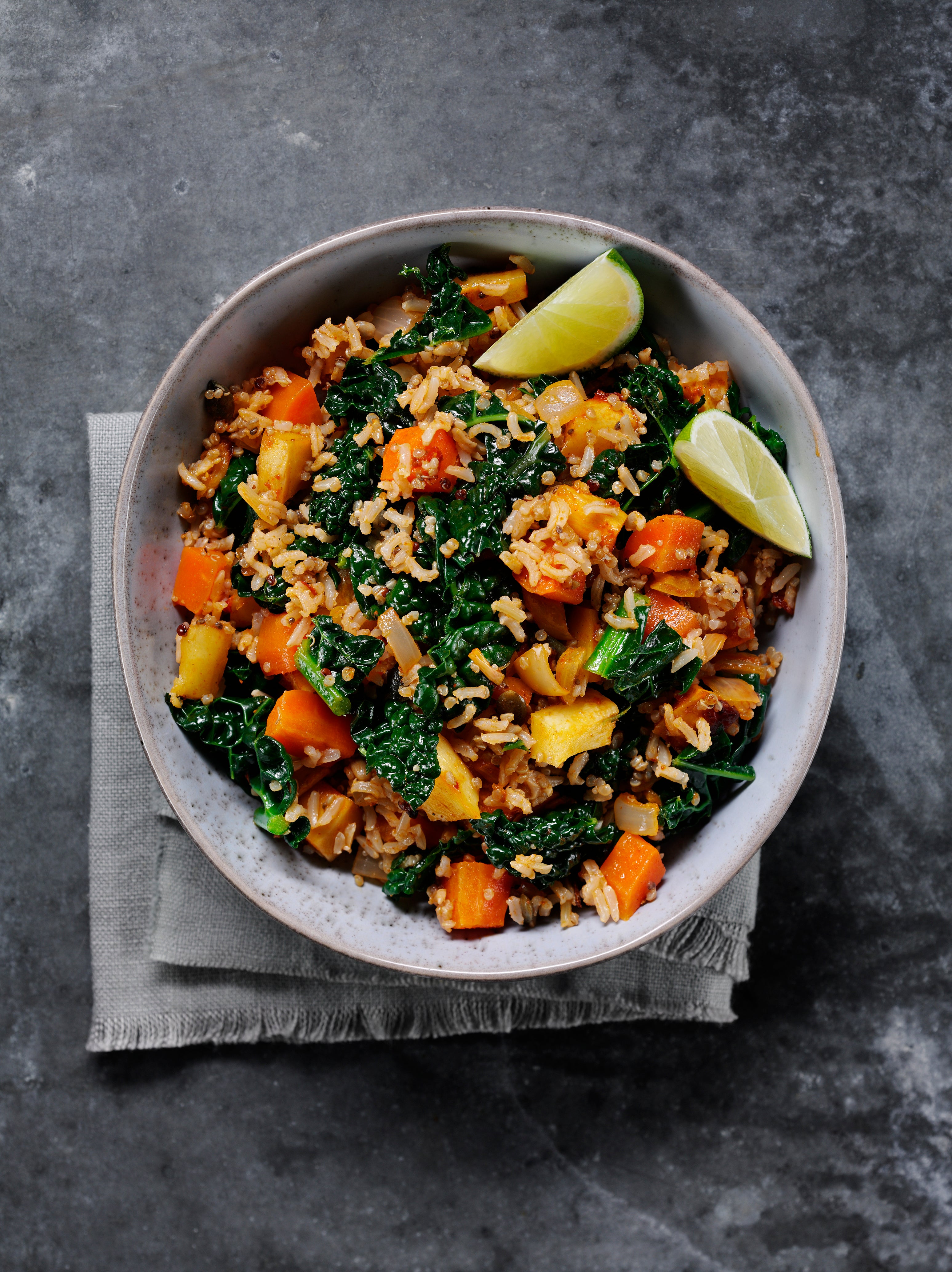
Fibre: 24g per portion
Serves: 4
Prep time: 15 minutes | Cook time: 30 minutes
Ingredients:
2 parsnips, diced
2 carrots, diced
1 onion, diced
2 tbsp olive oil
5cm piece root ginger, grated
1 tbsp harissa paste
200g pack sliced cavolo nero
250g pouch super seeds with quinoa and chia
200g brown basmati rice
Juice 1 lime
Yoghurt to serve
Method:
1. Preheat the oven to 200C, gas mark 6.
2. Place the parsnips, carrot and onion on a large baking tray and toss with 1 tbsp oil, ginger and harissa, season and roast for 20 minutes. Add the cavolo nero, the seed mix and toss in the remaining oil, roast for a further 10 minutes.
3. Meanwhile, cook the rice in boiling water for 20-25 minutes until tender and drain well.
4. Stir the rice into the vegetable mixture with the lime juice, season and serve with the yogurt.
Cooking tip: Great to use up leftover cooked rice. Try stirring in cooked prawns at the end.
Winter kale salad
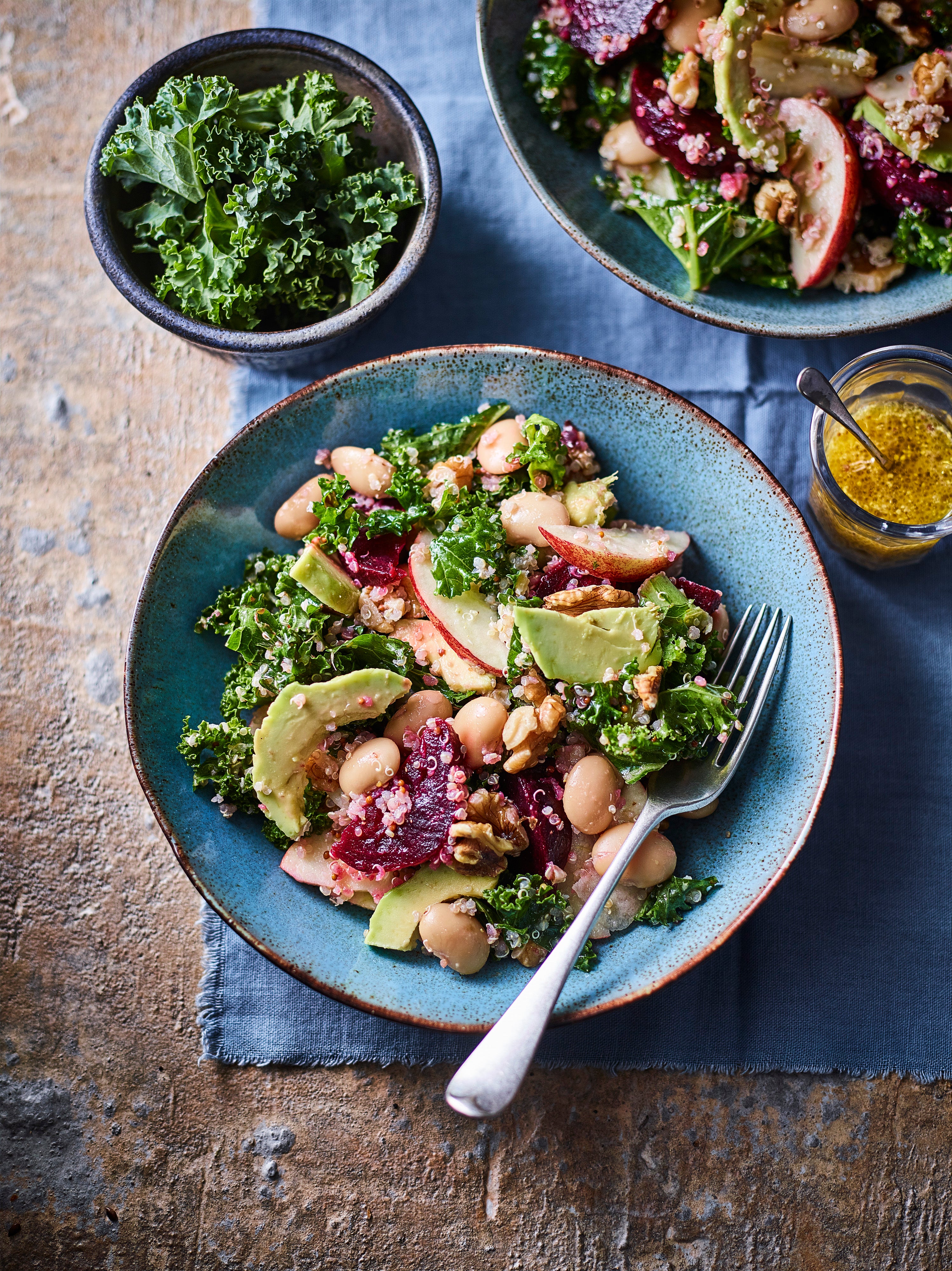
Fibre: 21g per portion
Serves: 2
Prep time: 10 minutes | Cook time: 15-20 minutes
Ingredients:
50g quinoa
2 tbsp extra virgin olive oil
1 tbsp cider vinegar
2 tsp wholegrain mustard (15g)
½ x 180g pack kale
400g can butter beans, drained and rinsed
1 red apple, cored and sliced
50g walnuts, chopped
1 ripe avocado, sliced 100g
80g cooked beetroot, cut into wedges
Method:
1. Cook the quinoa according to pack instructions, drain and run under cold water.
2. Meanwhile, whisk together the oil, vinegar and mustard, season to taste. Massage the dressing into the kale in a large bowl until softened slightly. Add in the butter beans, apple, walnuts, avocado and beetroot.
3. Stir in the quinoa to serve.
Cooking tip: Make kale crisps with the remaining bag of kale, great as a healthy snack.
Tofu spinach and bean soup
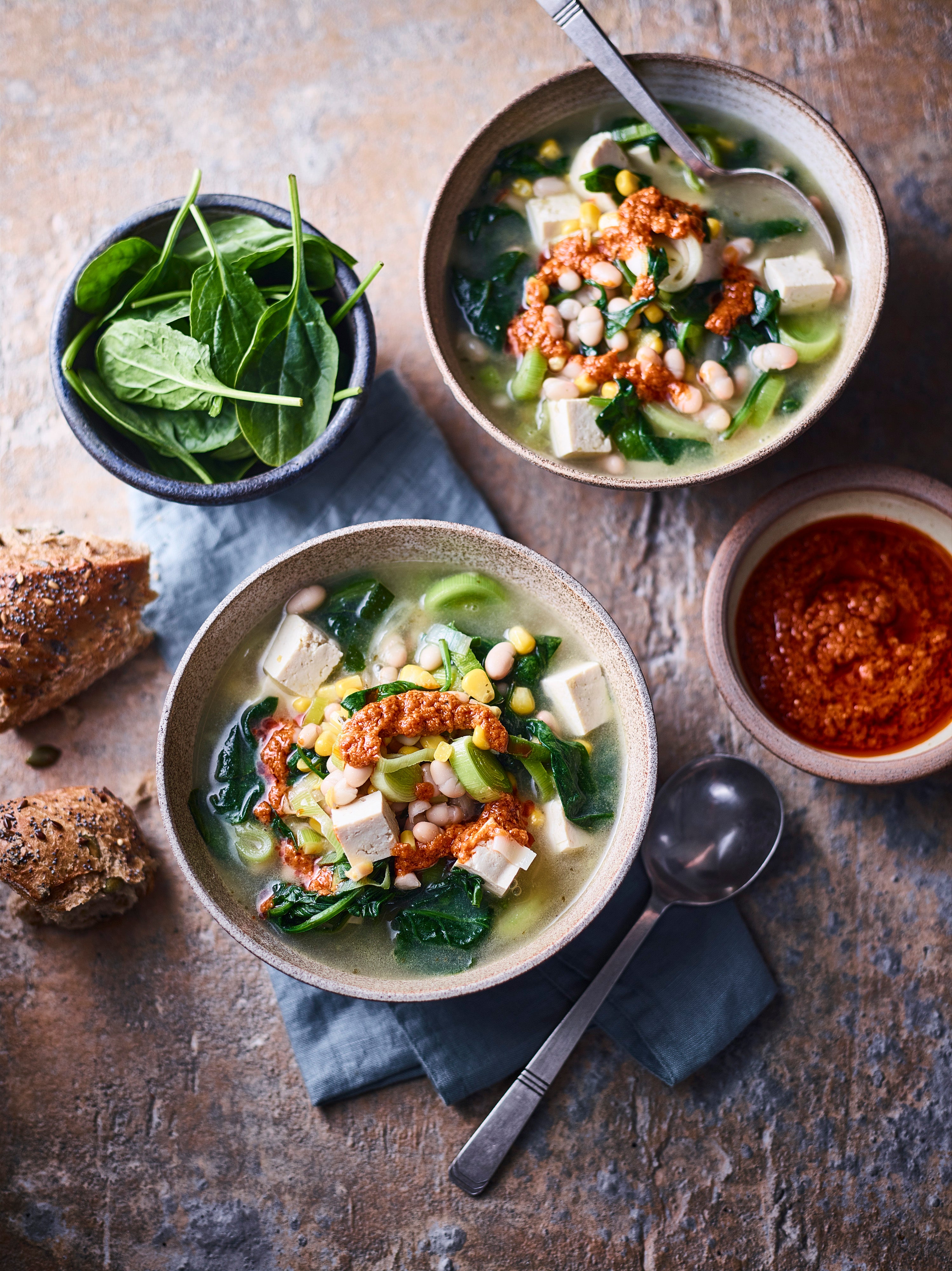
Fibre: 19g per portion
Serves: 4
Prep time: 15 minutes | Cook time: 30 minutes
Ingredients:
1 corn on the cob (150g)
1 tbsp olive oil
1 leek, sliced (200g)
500ml vegetable stock
280g pack extra firm tofu, diced
400g haricot beans, drained and rinsed
½ x 250g bag spinach
1 tbsp red pesto 20g
Juice half lemon
Method:
1. Cut the kernels of corn off the core with a sharp knife.
2. Heat the oil in a large saucepan and fry the corn and leeks for 3-4 minutes until softened. Stir in the stock, tofu and beans and simmer, covered, for 5 minutes, add the spinach until wilted.
3. Add a spoonful of pesto and a drizzle of lemon juice to serve.
Cooking tip: Try using smoked tofu and vegan pesto as an option.
Creamy potato and kale curry
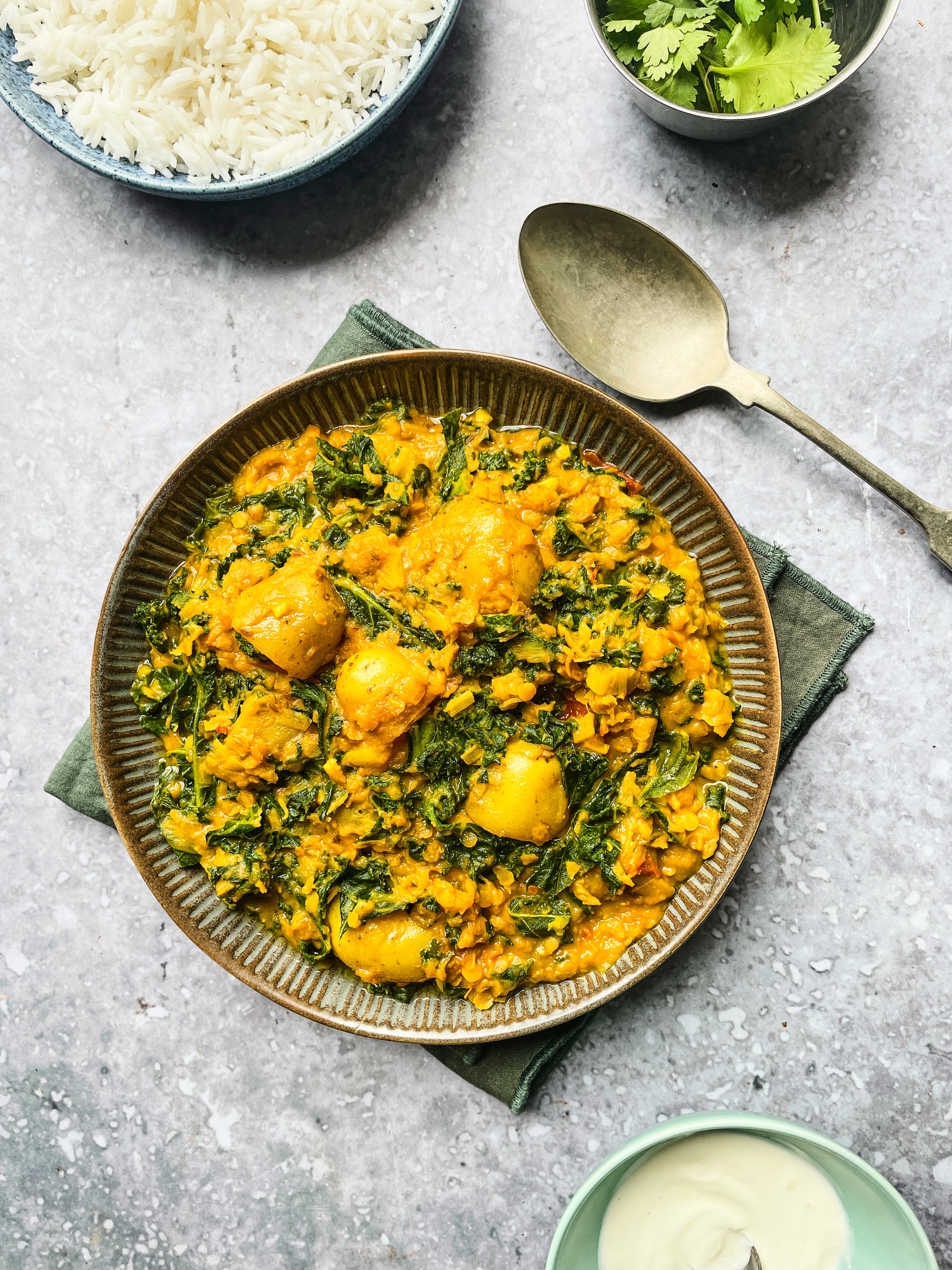
Fibre: 18g per portion
Serves: 4
Prep time: 5 minutes | Cook time: 20 minutes
Ingredients:
600g waxy potatoes, peeled and chopped into 1 inch cubes OR 600g salad potatoes (chopped in half if large)
2 tbsp veg oil
1 tsp cumin seeds
2 leeks, cleaned and trimmed
1 tsp turmeric
1 tsp ground coriander
3 garlic cloves, grated
½ tsp chilli flakes
5 tomatoes, roughly diced
200g red split lentils rinsed
500 ml veg stock
1 x 400ml low-fat coconut milk
250g bag of kale, trimmed
1 tsp garam masala
Method:
1. Add the potatoes in a large saucepan. Cover with boiling water and cook for 8-10 mins, or until just tender. Drain.
2. In the meantime, add the oil and cumin seeds to a frying pan. Allow them to sizzle to release their aromas.
3. Now add the leeks and remaining spices and fry for approx 5 minutes until tender.
4. Add the garlic and chilli flakes and stir to combine and fry for a further minute.
5. Add the chopped tomatoes and stir to combine.
6. Now add the red lentils, stock, coconut milk and simmer for 10 minutes.
7. Add the cooked potatoes, kale and additional water if needed (300ml) then cook for a further 5 minutes.
8. Finally, season to taste and add garam masala
Cooking tip: This is a hearty and substantial dish, so there’s no need for extra carbs. A vegetable side dish or raita is perfect. A great one for freezing.
Kale and walnut pasta primavera
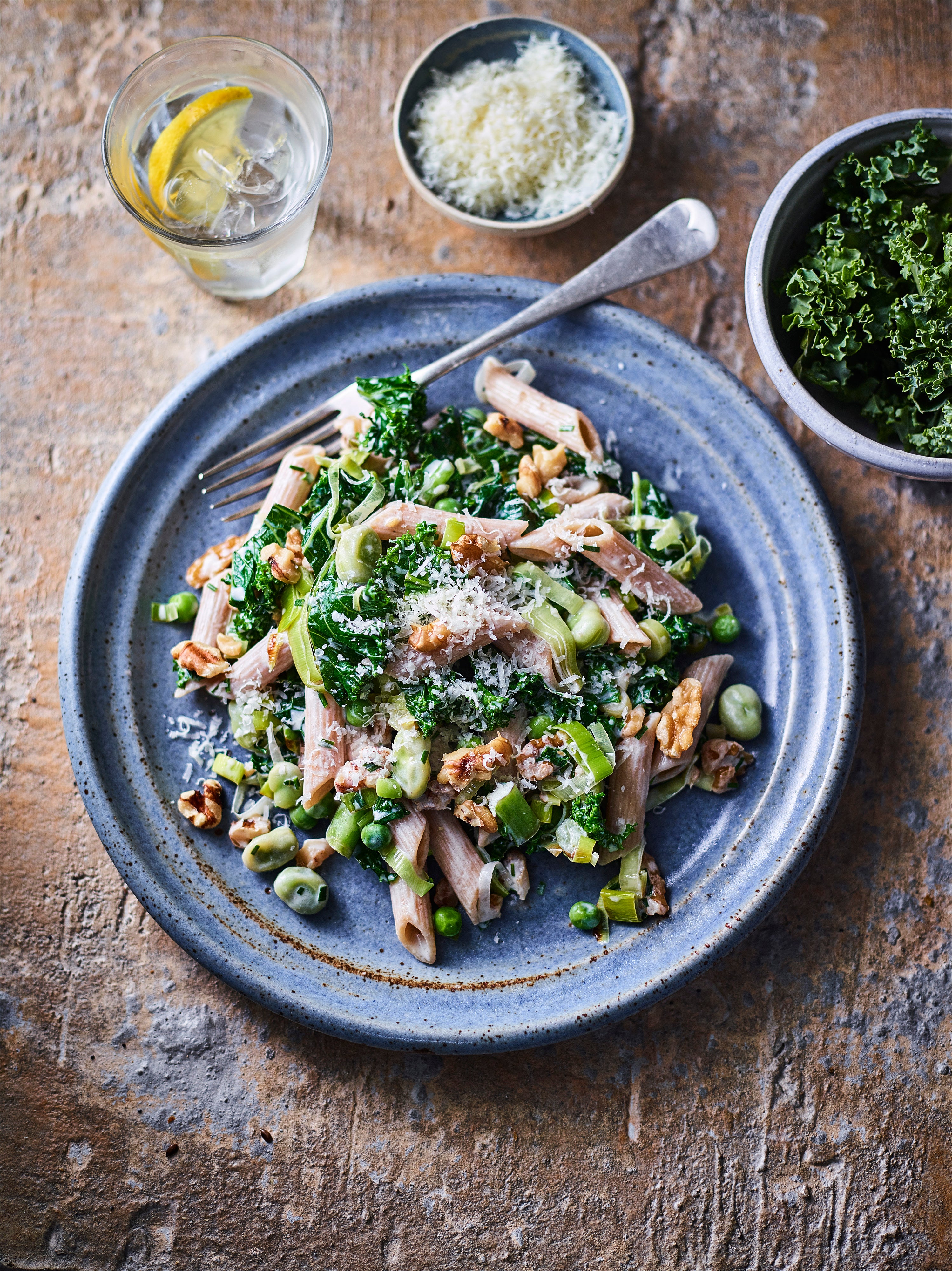
Fibre: 13g per portion
Serves: 4
Prep time: 15 minutes | Cook time: 30 minutes
Ingredients:
250g wholewheat penne pasta
100g frozen broad beans
100g frozen peas
180g bag kale
1 tbsp olive oil
1 leek, thinly sliced (200g)
75g walnuts, roughly chopped
2 tbsp chopped chives
165g tub light cream cheese
25g parmigiano reggiano, finely grated, plus extra to serve
Method:
1. Cook the pasta in boiling water for 12-13 minutes until just tender, remove with a slotted spoon and add the beans, peas and kale to the water, simmer for 4-5 minutes. Drain, reserving a little of the cooking water.
2. Meanwhile, heat the oil in a large frying pan and fry the leek and walnuts for 4-5 minutes until softened. Stir in the chives, cream cheese and the parmesan, heat gently to melt, adding a splash of the reserved cooking water. Stir in the pasta and vegetables to evenly coat.
3. Serve sprinkled with extra parmesan.
Cooking tips: Try any vegetables you may have in the freezer. Also a great way to use up leftover cooked vegetables.
Recipes from www.discovergreatveg.co.uk



Join our commenting forum
Join thought-provoking conversations, follow other Independent readers and see their replies
Comments